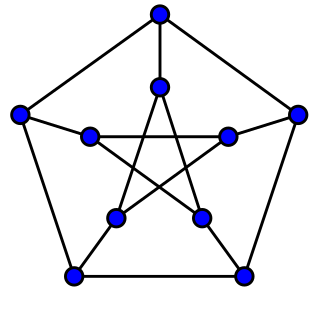
Pierre René, Viscount Deligne is a Belgian mathematician. He is best known for work on the Weil conjectures, leading to a complete proof in 1973. He is the winner of the 2013 Abel Prize, 2008 Wolf Prize, 1988 Crafoord Prize, and 1978 Fields Medal.
In mathematics, the Iwahori–Hecke algebra, or Hecke algebra, named for Erich Hecke and Nagayoshi Iwahori, is a deformation of the group algebra of a Coxeter group.

In mathematics, E8 is any of several closely related exceptional simple Lie groups, linear algebraic groups or Lie algebras of dimension 248; the same notation is used for the corresponding root lattice, which has rank 8. The designation E8 comes from the Cartan–Killing classification of the complex simple Lie algebras, which fall into four infinite series labeled An, Bn, Cn, Dn, and five exceptional cases labeled G2, F4, E6, E7, and E8. The E8 algebra is the largest and most complicated of these exceptional cases.

In the mathematical field of graph theory, a cubic graph is a graph in which all vertices have degree three. In other words, a cubic graph is a 3-regular graph. Cubic graphs are also called trivalent graphs.
The Fulkerson Prize for outstanding papers in the area of discrete mathematics is sponsored jointly by the Mathematical Optimization Society (MOS) and the American Mathematical Society (AMS). Up to three awards of $1,500 each are presented at each (triennial) International Symposium of the MOS. Originally, the prizes were paid out of a memorial fund administered by the AMS that was established by friends of the late Delbert Ray Fulkerson to encourage mathematical excellence in the fields of research exemplified by his work. The prizes are now funded by an endowment administered by MPS.
George Lusztig is a Romanian-born American mathematician and Abdun Nur Professor at the Massachusetts Institute of Technology (MIT). He was a Norbert Wiener Professor in the Department of Mathematics from 1999 to 2009.

David Kazhdan, born Dmitry Aleksandrovich Kazhdan, is a Soviet and Israeli mathematician known for work in representation theory. Kazhdan is a 1990 MacArthur Fellow.

Masaki Kashiwara is a Japanese mathematician. He was a student of Mikio Sato at the University of Tokyo. Kashiwara made leading contributions towards algebraic analysis, microlocal analysis, D-module theory, Hodge theory, sheaf theory and representation theory.
In the mathematical field of representation theory, a Kazhdan–Lusztig polynomial is a member of a family of integral polynomials introduced by David Kazhdan and George Lusztig. They are indexed by pairs of elements y, w of a Coxeter group W, which can in particular be the Weyl group of a Lie group.
In mathematics, the Bruhat order is a partial order on the elements of a Coxeter group, that corresponds to the inclusion order on Schubert varieties.

Alexander A. Beilinson is the David and Mary Winton Green University professor at the University of Chicago and works on mathematics. His research has spanned representation theory, algebraic geometry and mathematical physics. In 1999, Beilinson was awarded the Ostrowski Prize with Helmut Hofer. In 2017, he was elected to the National Academy of Sciences. In 2018, he received the Wolf Prize in Mathematics and in 2020 the Shaw Prize in Mathematics.
Jean-Luc Brylinski is a French-American mathematician. Educated at the Lycée Pasteur and the École Normale Supérieure in Paris, after an appointment as researcher with the C. N. R. S., he became a Professor of Mathematics at Pennsylvania State University. He proved the Kazhdan–Lusztig conjectures with Masaki Kashiwara. He has also worked on gerbes, cyclic homology, Quillen bundles, and geometric class field theory, among other geometric and algebraic topics.
In mathematics, an affine Hecke algebra is the algebra associated to an affine Weyl group, and can be used to prove Macdonald's constant term conjecture for Macdonald polynomials.
In mathematics, Deligne–Lusztig theory is a way of constructing linear representations of finite groups of Lie type using ℓ-adic cohomology with compact support, introduced by Pierre Deligne and George Lusztig.
In algebra and in particular in algebraic combinatorics, a quasisymmetric function is any element in the ring of quasisymmetric functions which is in turn a subring of the formal power series ring with a countable number of variables. This ring generalizes the ring of symmetric functions. This ring can be realized as a specific limit of the rings of quasisymmetric polynomials in n variables, as n goes to infinity. This ring serves as universal structure in which relations between quasisymmetric polynomials can be expressed in a way independent of the number n of variables.

Alexander Nikolaevich Varchenko is a Soviet and Russian mathematician working in geometry, topology, combinatorics and mathematical physics.

Kari Kaleva Vilonen is a Finnish mathematician, specializing in geometric representation theory. He is currently a professor at the University of Melbourne.

Xuhua He is a Chinese mathematician.

Wolfgang Soergel is a German mathematician, specializing in geometry and representation theory.










